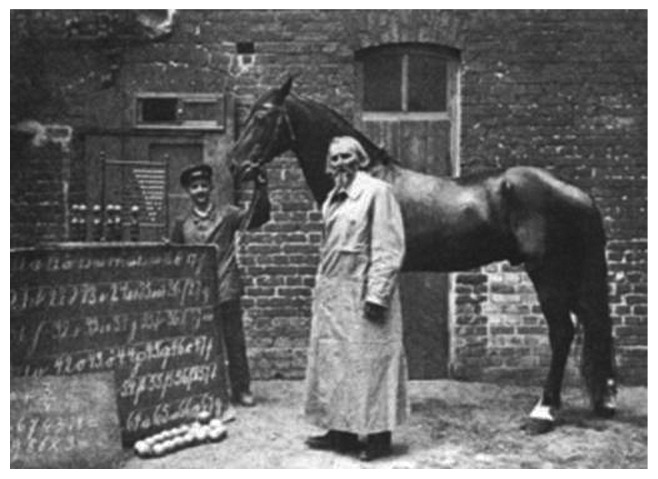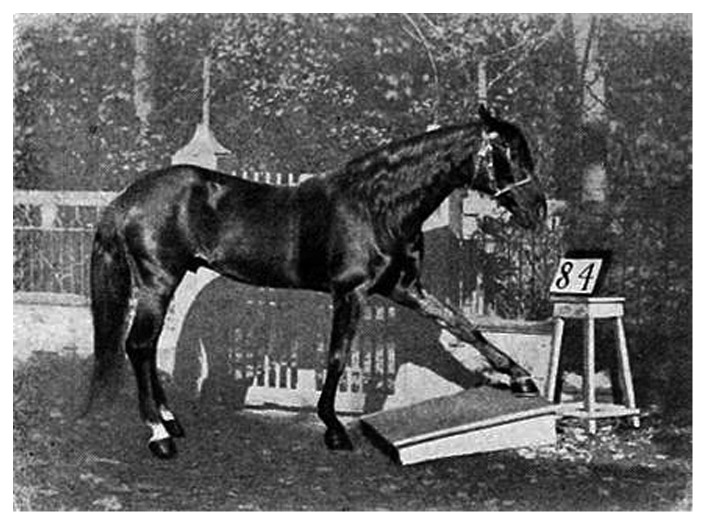Abstract
In the first decade of the 20th century, a horse named Hans drew worldwide attention in Berlin as the first and most famous “speaking” and thinking animal. Hans solved calculations by tapping numbers or letters with his hoof in order to answer questions. Later on, it turned out that the horse was able to give the correct answer by reading the microscopic signals in the face of the questioning person. This observation caused a revolution and as a consequence, experimenters avoided strictly any face-to-face contact in studies about cognitive abilities of animals—a fundamental lesson that is still not applied rigorously.
Do animals use language? If yes, can we understand it? These questions have long haunted man, both scientifically and in the popular imagination. The idea of communicating with animals is documented in religious legends, fables, and fairy tales. Popular examples are the biblical conversation between Eve and the mendacious snake about a forbidden fruit tree in the center of paradise1 and in Grimm’s fairy tales like “Cinderella,” where the 2 pigeons scream
“… there’s blood in the shoe …
the true bride waits for you …”
or in “Little Red Riding Hood” with the malicious speaking wolf.2
Examples for animal-human communication straddle perhaps all cultures and societies. In Indian folklore, the Panchatantra, one of the oldest collections of Indian fables (~300 BC) and believed to be written to educate young princes about statesmanship, is composed entirely of stories with anthropomorphic animals and birds. They talk among themselves as well as with humans. Russian folktales, perhaps among the most widespread, also abound in stories of animals and humans communicating, with talking cats and the famous “Baba Yaga,” a witch-like old woman who takes on several forms, transforming into animals with ease.3
The nostalgic dream of an intellectual interaction with animals came true about 100 y ago and caused enormous excitement worldwide. It began in 1904 in Berlin, and this famous story became known as the “Clever Hans Phenomenon.”4 The star of this episode was a horse named Hans. After 4 y of training by his master Wilhelm von Osten, a mathematics teacher, the horse was presented to the public.
The horse could count the number of persons in the audience, perform arithmetic operations, read the clock, recognize and identify playing cards, and knew the calendar of the whole year. In response to a question he would tap with his hooves either to indicate a number or the right option among many given. The obvious guess was that this was an elaborate hoax, set up through some means of training between horse and master. It soon became apparent, however, that Hans answered not only his trainer, but co-operated even in the absence of his master with any person he had never seen before. Hans performed arithmetic operations precisely, tapping numbers with his hoof and answered questions in the same way, using an alphabet with letters replaced by numbers (A = 1, B = 2, C = 3 …) on a blackboard in front of his eyes. Thus Hans combined letters to words, words to sentences, and sentences to thoughts and ideas. When he was shown a picture, Hans spelled the name of the painter. Similarly, he was able to identify the composer when melodies were played. Even rigorous questions of critical skeptics were answered correctly.
"Clever Hans" was hailed as the first and most famous "thinking" animal. Except a few skeptics, the majority of biologists, psychologists, and medical doctors, experts of all kind, and laymen were rather convinced by this example that animals are able to think in a human way and to express human ideas in non-verbal human language. In 1904, the German board of education even set up a commission to determine if the claims made about Hans were genuine. After an extended period—a year and a half of study—they concluded that there was no hoax involved. Finally in 1907, the phenomenon was explained by the meticulous examination of Professor Oscar Pfungst, a biologist and psychologist. He found that the horse was unable to answer any question if the questioning person did not know the answer, e.g., the composer’s name in case of a melody unknown to the questioner.Furthermore, the horse was unable to answer any question when a screen was placed such that it could not see the face of his examiner.
Consequently it turned out that the horse was an excellent and intelligent observer who could read the almost microscopic signals in the face of his master, thus indicating that it had tapped or was about to tap the correct number or letter and would receive a reward. In the absence of such a signal, he was unable to perform. Indeed, Pfungst himself found that he was unable to control these clues as the horse continued to answer correctly when his face was visible to it.5
As with most events that are given excessive publicity, “Clever Hans” was brought down rapidly from his pedestal. In some ways an unfair comedown, given that it was no mean achievement even to be able to read and interpret such signs from human facial indications. Cicero (106–43 BC) was not right when he stated that horses (and other animals) are without intelligence.6
The exact sad end of “Clever Hans” is not known in detail. At the beginning of World War I in 1914 he was drafted as a military horse and was killed in action in 1916 or was consumed by hungry soldiers. The take-home lesson of the “Clever Hans Phenomenon” is still valid but is unfortunately not respected by all members of the ethological community: During all studies of animal behavior, any face-to-face contact between the examiner and the experimental animal should be strictly avoided.
Otto Koehler7,8 was the first to postulate rigorously that any face-to-face contacts should be rigorously avoided during such animal experiments. He used movie cameras in order to avoid any direct animal contact for the documentation of his famous studies of the numerical competence of different birds9 in the first half of the past century. However, many important experiments, e.g., with “counting” gray parrots, with dogs, with dolphins, and with many other animals have in general been performed under face-to-face contact and are therefore, at least partly, of questionable value.
Unfortunately, the unwitting cues and microscopic signals in the face of the examiner have not been recorded with movie cameras and are mainly unidentified. It would therefore be highly desirable to train a horse in order to repeat and to reproduce the “Clever Hans Phenomenon,” so that it can be studied afresh. Interestingly, professional poker players know about the importance of unwitting cues and present a “poker-face,” even going so far as to wear dark sunglasses.
A recent study repeated the same error as was seen in the “Clever Hans” case,4,5 emphasizing the need to remember that lesson. Those studies implied that the numerical cognition of elephants differs from and is superior to that of all other animals.10,11 The experiments indicated that elephants defy the famous Weber’s Law (published around 1834 in Latin). The law states thatthe ability of an animal (or human) to discriminate between two quantities is a function of their ratios rather than the absolute difference between them. The study was soon criticized because of methodological deficits12,13 and the experiments were reproduced such that neither the experimenter nor the mahout (elephant keeper) knew where and how many pieces of food had been hidden. In summary, the major deficit10,11 was the neglect of the lesson we learned from “Clever Hans”: a semi transparent screen between the mahout and the food barrels, respectively, and the elephants, would have yielded correct results. That is, that elephants, like other animals, including humans, use an accumulator model in accordance with Weber’s Law. This study and others like it call for a revival of the memory of Clever Hans. (Figs. 1 and 2)
Figure 1. “Clever Hans,” an Orlov trotter horse (~1895—~1916) and his owner and teacher Wilhelm von Osten (1838—1909).
Figure 2. “Clever Hans” in action, tapping with his hoof: 8 – 4 = 4, 8 + 4 = 12, 8 / 4 = 2, and 8 x 4 = 32.
Disclosure of Potential Conflicts of Interest
No potential conflicts of interest were disclosed.
Acknowledgements
This publication was funded by the German Research Foundation (DFG) and the University of Wuerzburg in the funding programme Open Access Publishing.
Footnotes
Previously published online: www.landesbioscience.com/journals/cib/article/27122
References
- 1.Moses. Genesis; 3:1-6 [Google Scholar]
- 2.Jacob and Wilhelm Grimm [Internet]. Available from: www.grimmsstories.com
- 3.Chandler T, ed. Russian Magic Tales from Pushkin to Platonov. Penguin Classics, 2012. [Google Scholar]
- 4.Hediger HKP. The Clever Hans Phenomenon from an Animal Psychologist’s Point of View. In: Sebeok TA, Rosenthal R, eds. The Clever Hans Phenomenon: Communication with Horses, Whales, Apes and People. Ann NY: Acad Sci, 1981; 364:1-17. [Google Scholar]
- 5.Pfungst O. The Horse of Mr. von Osten. New York, NY: Holt, Rineheart, and Winston; 1911, 1965. [Google Scholar]
- 6.Marcus Tullius Cicero: De Officiis 2, §11: Expertes rationis equi, boves, reliquae pecudes, apes, quorum opera efficitur aliquid ad usum hominum atque vitam = “Without intelligence are horses, cattle, other domestic animals and bees, by the work of which something is achieved for the use and for the livelihood of humans.”
- 7.Koehler O. Vom Erlernen unbenannter Anzahlen bei Vögeln. Naturwissenschaften. 1941;29:201–18. doi: 10.1007/BF01481755. [DOI] [Google Scholar]
- 8.Koehler O. The ability of birds to “count”. Bull. Anim. Behav. Soc. 1950;9:41–5. [Google Scholar]
- 9.Anonymous Ability of birds to count. Nature. 1951;168:373–5. doi: 10.1038/168373a0. [DOI] [Google Scholar]
- 10.Irie-Sugimoto N, Kobayashi T, Sato T, Hasegawa T. Relative quantity judgment by Asian elephants (Elephas maximus) Anim Cogn. 2009;12:193–9. doi: 10.1007/s10071-008-0185-9. [DOI] [PubMed] [Google Scholar]
- 11.Irie N, Hasegawa T. Summation by Asian elephants (Elephas maximus) Behav Sci. 2012;2012:50–6. doi: 10.3390/bs2020050. [DOI] [PMC free article] [PubMed] [Google Scholar]
- 12.Perdue BM, Talbot CF, Stone AM, Beran MJ. Putting the elephant back in the herd: elephant relative quantity judgments match those of other species. Anim Cogn. 2012;15:955–61. doi: 10.1007/s10071-012-0521-y. [DOI] [PubMed] [Google Scholar]
- 13.Agrillo C, Miletto Petrazzini ME. The importance of replication in comparative psychology: the lesson of elephant quantity judgments. Front Psychol. 2012;3:181. doi: 10.3389/fpsyg.2012.00181. [DOI] [PMC free article] [PubMed] [Google Scholar]




